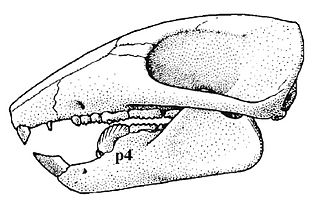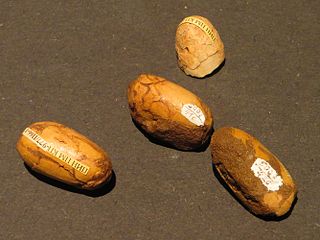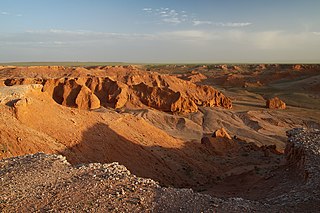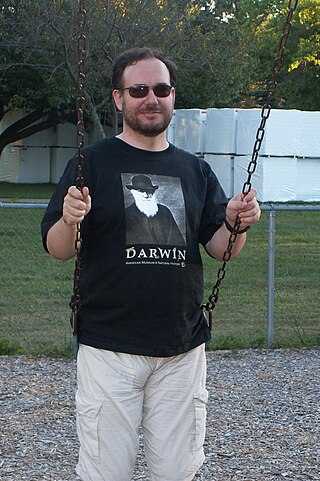
Tarbosaurus is a genus of large tyrannosaurid dinosaur that lived in Asia during the Late Cretaceous epoch, about 70 million years ago. It contains the single type species: Tarbosaurus bataar, which is known from the Nemegt Formation of Mongolia, with more fragmentary remains found further afield in the Subashi Formation of China. Tarbosaurus is represented by dozens of fossil specimens, including several complete skulls and skeletons. These remains have allowed studies focusing on its phylogeny, skull mechanics, and brain structure. Further fossil remains have been reported from other geologic formations of Asia, however, these remains are fragmentary and can not be confidentially assigned to Tarbosaurus or the type species.
Eobaatar is a genus of extinct mammal from the Lower Cretaceous of Mongolia, Spain and England. A member of the also extinct order Multituberculata, it lies within the suborder Plagiaulacida and family Eobaataridae. The genus Eobaatar was named by Kielan-Jaworowska Z., Dashzeveg D. and Trofimov B.A. in 1987. Its name was made from Greek "eos" = "dawn" and Mongolian "baatar" = "hero"", "warrior".

Kamptobaatar is a Mongolian mammal genus from the Upper Cretaceous. It lived at the same time as the later dinosaurs. This animal was a member of the extinct order Multituberculata within the suborder Cimolodonta and family Sloanbaataridae.
Bulganbaatar is an extinct genus of early mammals from the Upper Cretaceous.

Chulsanbaatar is an extinct genus of mammal from the Cretaceous of Mongolia. It was a member of the order of Multituberculata and is within the suborder Cimolodonta. The genus Chulsanbaatar was named by Zofia Kielan-Jaworowska in 1974, after the locality of Khulsan near the dig sites where these organisms were found, and Ulan Bator, the capital of Mongolia.

Nemegtbaatar is an extinct genus of mammal from the Upper Cretaceous Period of what is now Central Asia. It belonged to the order Multituberculata. Nemegtbaatar is within the suborder Cimolodonta and is a member of the superfamily Djadochtatherioidea.

Catopsbaatar is a genus of multituberculate, an extinct order of rodent-like mammals. It lived in what is now Mongolia during the late Campanian age of the Late Cretaceous epoch, about 72 million years ago. The first fossils were collected in the early 1970s, and the animal was named as a new species of the genus Djadochtatherium in 1974, D. catopsaloides. The specific name refers to the animal's similarity to the genus Catopsalis. The species was moved to the genus Catopsalis in 1979, and received its own genus in 1994. Five skulls, one molar, and one skeleton with a skull are known; the last is the genus' most complete specimen. Catopsbaatar was a member of the family Djadochtatheriidae.

Kryptobaatar, also known as Gobibaatar or Tugrigbaatar, is an extinct mammalian genus dating from the Upper Cretaceous Period and identified in Central Asia. This animal was a member of the extinct order of Multituberculata within the suborder Cimolodonta, and was a member of the family Djadochtatheriidae. It lived contemporaneously with some of the dinosaurs. Its skull had a length of perhaps 3 cm.

Deinocheirus is a genus of large ornithomimosaur that lived during the Late Cretaceous around 70 million years ago. In 1965, a pair of large arms, shoulder girdles, and a few other bones of a new dinosaur were first discovered in the Nemegt Formation of Mongolia. In 1970, this specimen became the holotype of the only species within the genus, Deinocheirus mirificus; the genus name is Greek for "horrible hand". No further remains were discovered for almost fifty years, and its nature remained a mystery. Two more complete specimens were described in 2014, which shed light on many aspects of the animal. Parts of these new specimens had been looted from Mongolia some years before, but were repatriated in 2014.
Cretaceous Mongolia is one of the strangest and best preserved of all Mesozoic ecosystems. The shifting sand of what was, even then, the Gobi Desert have ensured that fossils of the animals that lived there can be found in exactly the position in which they were buried, with most of the bones together. The most notable fossil, dubbed the Fighting Dinosaurs, is the very well preserved remains of a Velociraptor, locked in combat with a Protoceratops, a small ceratopsian.

Nemegtosaurus was a sauropod dinosaur from the Late Cretaceous Period of what is now Mongolia. It was named after the Nemegt Basin in the Gobi Desert, where the remains — a single skull — were found. The skull resembles diplodocoids in being long and low, with pencil-shaped teeth. However, recent work has shown that Nemegtosaurus is in fact a titanosaur, closely related to animals such as Saltasaurus, Alamosaurus and Rapetosaurus.

Opisthocoelicaudia is a genus of sauropod dinosaur of the Late Cretaceous Period discovered in the Gobi Desert of Mongolia. The type species is Opisthocoelicaudia skarzynskii. A well-preserved skeleton lacking only the head and neck was unearthed in 1965 by Polish and Mongolian scientists, making Opisthocoelicaudia one of the best known sauropods from the Late Cretaceous. Tooth marks on this skeleton indicate that large carnivorous dinosaurs had fed on the carcass and possibly had carried away the now-missing parts. To date, only two additional, much less complete specimens are known, including part of a shoulder and a fragmentary tail. A relatively small sauropod, Opisthocoelicaudia measured about 11.4–13 m (37–43 ft) in length. Like other sauropods, it would have been characterised by a small head sitting on a very long neck and a barrel shaped trunk carried by four column-like legs. The name Opisthocoelicaudia means "posterior cavity tail", alluding to the unusual, opisthocoel condition of the anterior tail vertebrae that were concave on their posterior sides. This and other skeletal features lead researchers to propose that Opisthocoelicaudia was able to rear on its hindlegs.

Bagaceratops is a genus of small protoceratopsid dinosaurs that lived in Asia during the Late Cretaceous, around 72 to 71 million years ago. Bagaceratops remains have been reported from the Barun Goyot Formation and Bayan Mandahu Formation. One specimen may argue the possible presence of Bagaceratops in the Djadochta Formation.

Tylocephale is a genus of pachycephalosaurid dinosaur, a group of dome-headed, herbivorous ornithischians, that lived during the Late Campanian stage of the Late Cretaceous in what is now Mongolia. It is known from a partial skull and associated mandible that were unearthed in 1971 by a Polish-Mongolian Expedition to the Barun Goyot Formation of the Gobi Desert. The specimen was described in 1974 by Polish paleontologists Teresa Maryańska and Halszka Osmólska as a new genus and species.

Gobipteryx is a genus of prehistoric bird from the Campanian Age of the Late Cretaceous Period. It is not known to have any direct descendants. Like the rest of the enantiornithes clade, Gobipteryx is thought to have gone extinct near the end of the Cretaceous.

The Djadochta formation is a highly fossiliferous geological formation in Central Asia, Gobi Desert, dating from the Late Cretaceous period, about 75 million to 71 million years ago. The type locality is the Bayn Dzak locality, famously known as the Flaming Cliffs. Reptile and mammal remains are among the fossils recovered from the formation.
Teresa Maryańska was a Polish paleontologist who specialized in Mongolian dinosaurs, particularly pachycephalosaurians and ankylosaurians. Peter Dodson states that in 1974 Maryanska together with Halszka Osmólska were among the first "women to describe new kinds of dinosaurs". She is considered not only as one of Poland's but also one of the world's leading experts on dinosaurs.

Karol Sabath was a Polish biologist, paleontologist and paleoartist. He was employed by the Instytut Paleobiologii of the Polska Akademia Nauk - Institute of Paleobiology, Polish Academy of Sciences, Warsaw. He also worked for National Geographic magazine, the Museum of the Polish Geological Institute, the European edition of Scientific American, and various other publishing houses in Poland. He authored many popular-science books for children, did translations, and wrote popular-science articles for Polish national newspapers. He was a scientific advisor for many popular-science events, including reconstructions of paleobiological environment and specimens.

Zofia Emilia Kielan-Jaworowska was a Polish paleobiologist. In the mid-1960s, she led a series of Polish-Mongolian paleontological expeditions to the Gobi Desert. She was the first woman to serve on the executive committee of the International Union of Geological Sciences. The most notable dinosaur species she discovered include: Deinocheirus and Gallimimus while Kielanodon and Zofiabaatar were named in her honour.
The "Gurlin Tsav" skull is a currently unnamed carnivorous metatherian fossil from the Nemegt Formation of Mongolia. Composed of a single semi-complete skull, this specimen is notable in regards to the evolution and systematics of Metatheria as a whole, and thus nigh-omnipresent in phylogenetic analyses of this group.






















